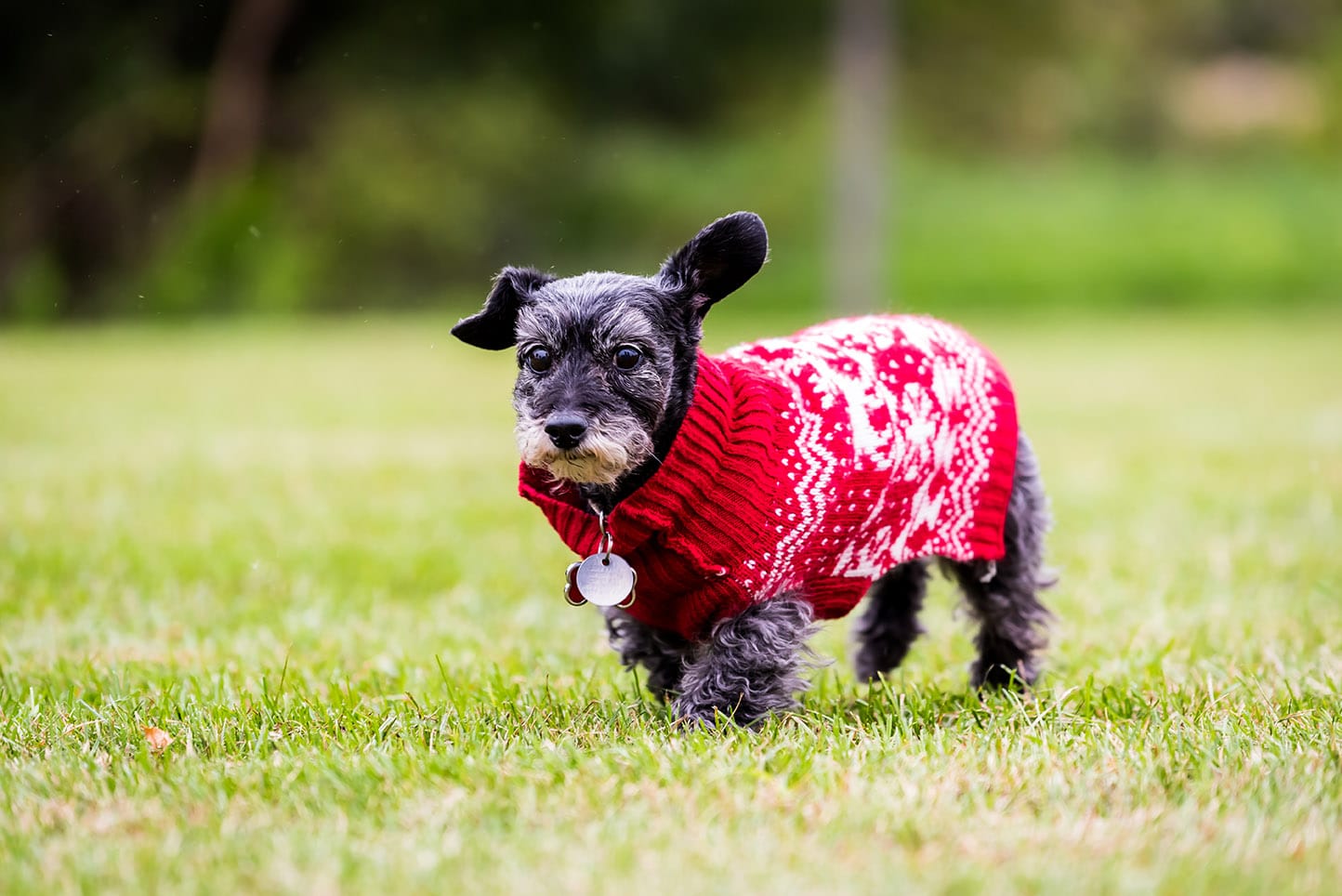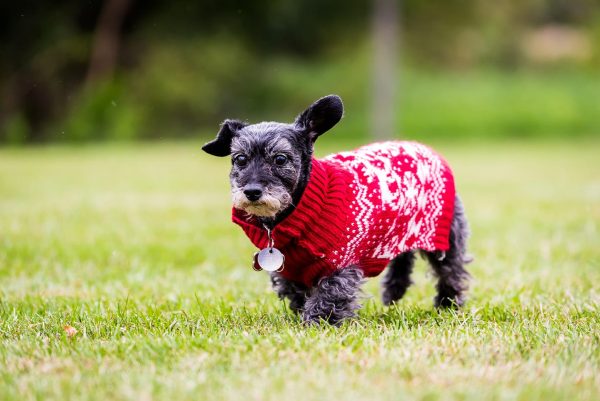Click Below to Skip Ahead
The Miniature Schnoxie is the perfect designer dog for you if you want a small breed that is loyal, fun to be around, and a great watchdog. Its small size means that you could live with the Miniature Schnoxie just about anywhere, all while enjoying its energetic nature and playful spirit.
Breed Overview
Height:
8 – 14 inches
Weight:
15 – 30 pounds
Lifespan:
12 – 15 years
Colors:
Brown, black, white, silver, tan, grey, and red
Suitable for:
Playful families, apartment or home dwellers who spend a lot of time outside
Temperament:
Loyal, willful, active, watchdog
Even though Miniature Schnoxies have great personalities, they aren’t fit for everyone. Because of their willfulness, Miniature Schnoxies are difficult to train. Many beginner dog trainers will have difficulty with this breed. Likewise, they can have serious grooming requirements, depending on their coat.
Nevertheless, the Miniature Schnoxie makes a great pet because of its small size, fun personality, and watchdog-like barking. Just make sure that you’re ready to take command of a willful dog and play with it quite a bit, especially if you live in an apartment.
Miniature Schnoxie Puppies
It is unlikely to find Miniature Schnoxie puppies at a shelter simply because they are a designer breed. So, you will likely need to look for a specific breeder in your area. Make sure to interview the breeder to ensure that they are reputable and responsible. Be ready to ask the breeder many questions and to visit the breeding facilities before making a payment. Also, ensure they let you meet the puppy’s parents so you have an idea of the puppy’s health and temperament.
After having your pup, you will still need to pay for annual medical basics (vet visits and medicine) and non-medical essentials (food and toys) for your dog to remain happy and healthy. Miniature Schnoxies tend to be loyal to their owners and create strong bonds with their families.

Temperament & Intelligence of the Miniature Schnoxie
The Miniature Schnoxie is a willful but well-behaved and loyal small dog. It gets along well with most families, regardless of children in the household, other pets, and size of the house. As with any other dog, early socialization and consistent training are required for your Miniature Schnoxie to be predictably well-behaved with all people and animals.
Are These Dogs Good for Families?
Miniature Schnoxies are typically good with families because they aren’t a known aggressive breed and love to play. Singles and homes with many children alike will love a Miniature Schnoxie in the home. With early socialization, the Miniature Schnoxie can get along with just about anyone.
When it comes to children, Miniature Schnoxies tend to be great, especially if socialized early. They aren’t aggressive, but they also like playing with children, which means both the children and the dog will benefit from youthful energy in the house.
The Miniature Schnoxie can fit into most sized homes too. If you live in an apartment, its small size means that it won’t be too cramped, but you still need to exercise the dog regularly. If you have a yard, your Miniature Schnoxie will be equally as happy with more space to play.
Does This Breed Get Along with Other Pets?
Miniature Schnoxies tend to be good with other pets, such as cats and dogs. If you know other animals will be introduced to your Miniature Schnoxie at some point, try socializing the dog as early as possible for the best results.
The only animals that Miniature Schnoxies don’t pair particularly well with are small animals. These dogs are known to chase animals smaller than them when given the opportunity, such as small rodents or birds. Any animals close to their size will get along fine, though.
If you have smaller animals in the household, just make sure that they are kept away from the dog. For example, keep your small rodent inside a cage where it is safe from your Miniature Schnoxie.
Things to Know When Owning a Miniature Schnoxie:
In many respects, owning a Miniature Schnoxie is relatively easy, but they do need to be entertained or else they can be destructive. Their grooming requirements will depend on the coat type they inherited. Some dogs have easy grooming, whereas others need more help.
One downside to all Miniature Schnoxies is training. These dogs are notoriously difficult to train, not because of lack of intelligence but of stubbornness. Even though they likely won’t act out directly, making them follow your commands can be a bit difficult.
Because of the difficulty of training, as well as the potential grooming requirements, Miniature Schnoxies are best for experienced owners, but their likable nature means that beginner owners who are up to the challenge can succeed as well.
Food & Diet Requirements
Miniature Schnoxies don’t need a lot of food. Only feed them about half a cup of dry dog food twice a day. Puppies and younger dogs may need their food dispersed more throughout the day. Make sure not to leave dog food out all day because these dogs are known to overeat and become obese.
Although you should not leave a bowl of food out, make sure to have fresh water available constantly. Since these dogs are so active, they get thirsty more often than other small breeds.
Exercise
Even though Miniature Schnoxies are small dogs, they have a large exercise requirement. It is important that this dog gets daily outside exercise time and socialization with other dogs and people.
Luckily, the dog’s small size means that it can get all of the exercise it needs indoors on a rainy day or in an apartment. Just make sure to play with your dog and provide it with numerous toys.
Any time you take your Miniature Schnoxie outside, make sure that it is leashed up or safe within a fence. Because these dogs are prone to chasing things that run, the breed can easily run away, get lost, or get injured if it sees something on the go.
Training
Miniature Schnoxies are notoriously difficult to train. Even though they aren’t intentionally stubborn, they have an independent streak that makes them difficult for new dog owners to train. If you are a new dog owner, we recommend hiring a dog training professional to help you get your Miniature Schnoxie in shape.
When training a Miniature Schnoxie, it is important to be consistent, firm, positive, and patient. If you are unreliable and inconsistent, your Miniature Schnoxie won’t learn anything. At the same time, being too harsh or negative causes the Miniature Schnoxie to fear you and potentially shy away from the task.
Because Miniature Schnoxies can be so willful, start training as early as possible. Much like early socialization, training will go smoother if you start it as young as you can.
Grooming ✂️
Grooming requirements of your Miniature Schnoxie depend on the coat type. Most Miniature Schnoxies will need to be brushed anywhere from twice a week to daily. Generally speaking, shedding is low, but shedding can kick up a bit during shedding seasons. If your Miniature Schnoxie has a long or wiry coat, you will need to take it to the groomer to get trimmed and stripped.
Even though it may be tempting to give your dog a bath frequently, refrain from doing so. Frequent bathing damages Miniature Schnoxie’s natural oils and skin. Given that this breed is already prone to dry skin and skin problems, you don’t want to exacerbate the issue.
Clean out your Miniature Schnoxie’s ears once a week too. You can do this by gently wiping down the ears. Make sure to check for infection while you are doing this. Furthermore, trim the dog’s nails when needed and brush its teeth two to three times every week.
Health and Conditions
Even though Miniature Schnoxies are a long-lived breed, they are susceptible to certain health conditions. Responsible breeding helps to prevent these conditions, but they can still develop even with a responsible breeder.
- Epilepsy
- Eye problems
- Ear infections
- Skin problems
- Diabetes
- Von Willebrands
- Congenital Megaesophagus
- Back problems
- Bloat
- Obesity
3 Little-Known Facts About the Miniature Schnoxie
1. Miniature Schnoxies are designer dogs.
Miniature Schnoxies are designer dogs because they are a mixture of the Dachshund and Miniature Schnauzer. As a result, Miniature Schnoxies have the body of a Dachshund but the coat of a Schnauzer, creating an adorable dog that everyone loves.
2. Most Miniature Schnoxies have purebred parents.
Today, most Miniature Schnoxies have purebred parents, one being a purebred Dachshund and the other one being a purebred Miniature Schnauzer. The Miniature Schnoxie itself is not a purebred since it is not an official breed.
When these dogs first became popular, the same was not true of their parents’ lineage. Many breeders took advantage of their popularity, and overbred and inbred Miniature Schnoxies, Dachshund, and Mini Schnauzers. That is why it is important to select a reputable breeder for your Miniature Schnoxie puppy.
3. Miniature Schnoxies make good guard dogs.
Despite their small size, Miniature Schnoxies make great watchdogs because they are known to get loud and rambunctious if a newcomer walks onto the property. Although they won’t be aggressive to most new people, you can count on this dog to alert you when someone is on the premises.
Final Thoughts
Miniature Schnoxies are a great breed because of their small size, loyalty, and fun personality. Whether you have other dogs or young children in the household, a Miniature Schnoxie is likely to fit in perfectly, but make sure to socialize the dog early.
You should not get a Miniature Schnoxie if you are not prepared to take on the challenging task of training and grooming. Even though these dogs are not aggressive or necessarily bad, their willfulness can be troublesome if you’ve never trained a dog before.
If you take the time to train your puppy properly and socialize it early, you should have a lot of fun and meaningful connections with your Miniature Schnoxie.
See also:
- Chonzer (Bichon Frise & Miniature Schnauzer Mix)
- Crested Schnauzer (Miniature Schnauzer & Chinese Crested Mix)
- Miniboz (Miniature Schnauzer & Boston Terrier Mix)
Featured Image Credit: Debra Anderson, Shutterstock









